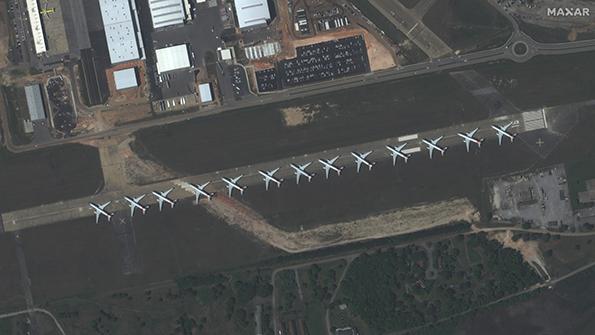
Companies have good quarters and bad quarters, but rarely does a whole industry sound like it just got sucker-punched. That’s what the next few weeks will be like in the aerospace and defense sector, and for sure there will be headlines describing industrial carnage as the industry gasps for air and works to recover after COVID-19.
The truth is the aerospace and defense (A&D) supply chain suddenly is far too large for what is needed, maybe by a quarter or a third of excess capacity. As a result, quick or methodical cutbacks in manufacturing and services are expected throughout the syndicates that make airliners, business jets and other aircraft. As public companies report their latest quarterly financial results in late April and May, they will have to address the year ahead and offer insight into their response plans.
Unfortunately, business as usual prior to COVID-19 is not expected until 2022 or later, according to numerous analysts and advisors. And that is just too long to carry extra financial costs, which means all levels will feel pain. “The COVID-19 decline is a serious risk for commercial OEM plays—Boeing, Spirit AeroSystems, Allegheny Technologies, Hexcel, Howmet Aerospace, Triumph Group and Carpenter Technology,” Cowen analysts say. “Aftermarket ‘relative safe havens’ Honeywell International, Heico and TransDigm Group also face stiff near-term headwinds, with more serious risks at General Electric.”
If OEMs and their Tier 1 and 2 suppliers are already cutting their workforces, slashing executive salaries and suspending shareholder returns—as dozens have announced since the novel coronavirus began sweeping through the U.S. in March—then it is easy to imagine that much lower tiers with their even thinner margins could face existential reckonings.
“People who didn’t plan for it were unreasonably naive,” asserts Avitas consultant Adam Pilarski, a longtime expert who espoused a bearish view on commercial aviation long before the Boeing 737 MAX crisis started gumming up business models. “There is no magic potion here. You will have less production.”
While Pilarski’s comment may come across as harsh, it accurately describes the depth of the coming paradigm shift for commercial aviation. Yes, perhaps it was too much to have asked OEMs and suppliers to model for a 95% collapse in passenger air traffic and two-thirds of large commercial aircraft fleets getting parked—including brand-new deliveries. But practically no one seemed to imagine simultaneous cuts to new orders, standing backlogs and aftermarket revenue streams. Indeed, Pilarski was one of the few who envisioned an environment with much less than the traditional 5% annual growth in air traffic.
That is now changing: Airbus has revealed narrowbody and widebody production rate cuts of about a third, and Boeing is expected to follow suit any day.
According to Credit Suisse analysts, such sudden rate changes will have a materially negative impact on the supply chain because the effect is exponential. “[The supply chain] will need to cut production by much more as Airbus consumes its inventories—for instance, potentially going to rate 20 on the A320 for some months and ramping up again to 40,” the Credit Suisse analysts say. Boeing’s inventory—including roughly 800 MAXs that are backed up with its customers and supplier Spirit AeroSystems and are waiting to join its own fleets—is worse.
Still, it is not that simple to look at customers such as Airbus and Boeing and draw a direct line to suppliers to guess their fate. While the vast majority of publicly traded A&D companies have shelved the 2020 forecasts they offered just weeks before, almost no one has outlined new plans. For one thing, few suppliers had even received change orders as of early April, Ken Herbert of Canaccord Genuity says.
Here are three factors to watch for in earnings reports to discern how the supply chains will change.
First, how much U.S. government aid will companies receive? This is a significant variable, and as of mid-April, we still did not know how much even sector leader Boeing will receive (presuming it does). “Most suppliers we have spoken with are still waiting for more clarity on the exact terms available under the CARES Act,” says Herbert, who has deep ties in the A&D supply chain. Meanwhile, many public companies have been able to tap short-term financing or debt markets to boost liquidity—a testament to their prior investment grades.
Second, the supply chain has experienced robust vetting and stress-testing over the past decade. Did it work? Record growth, record mergers and acquisitions, and record private equity involvement have dramatically consolidated industry (for better or worse). Yes, it meant elimination of countless companies, and some smaller survivors remain stressed by technology investments and meager working capital accounts. But top-tier companies have been working to eliminate chokepoints and shore up weak links in their supply chains for the last few years, ironically as they sought to raise rates.
Finally, many companies became less susceptible one way or another, especially through revenue diversification (see chart). Take the new Raytheon Technologies, the first supplier to rival its OEM customers in annual sales. Manufacturers elbowed into the aftermarket; commercial providers and defense suppliers tapped into each other’s markets; and venture capitalists and billionaire competitors entered into and prodded new technology advances that legacy industry had resisted funding, among other trends. Will this lead to resilience?
Some think so. “In many ways, the supply chain is now more mature, diversified and well-positioned to handle this economic downturn versus in 2001 and 2008,” says Alex Krutz, managing director at Patriot Industrial Partners, an advisory firm focused on operations and supply chain. “A large number of suppliers over this last decade have taken significant steps to ensure their long-term success.”
There are sure to be industrial casualties as A&D faces its greatest business falloff in history. We should mourn the loss of skilled workers and devoted people who are forced to exit the sector, but there are still new aircraft to build. And there will be supply chains to do it.





